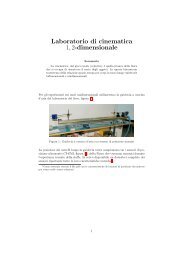Newton's law of cooling revisited - Cartan
Newton's law of cooling revisited - Cartan
Newton's law of cooling revisited - Cartan
Create successful ePaper yourself
Turn your PDF publications into a flip-book with our unique Google optimized e-Paper software.
1064 M Vollmer<br />
is no additional heating involved [3]. Many modern textbooks present this <strong>law</strong> in another way<br />
to describe the physics behind the exponential decrease by stating Newton’s <strong>law</strong> to mean that<br />
the heat transfer from an object to the surrounding is proportional to the respective temperature<br />
difference (e.g. [1], the very helpful comment by Bohren [3]; see also [4]). The respective<br />
time constant τ in the exponential function is characteristic for the object under study, i.e. it<br />
depends on its properties (heat capacity, size, geometry [5, 6]etc).<br />
In the last few decades, quite a number <strong>of</strong> publications dealt with Newton’s <strong>law</strong> <strong>of</strong> <strong>cooling</strong>.<br />
Some historical notes can be found in [7, 8]. The nearly endless discussions about Newton’s<br />
<strong>law</strong> <strong>of</strong> <strong>cooling</strong> may be summarized by the statement <strong>of</strong> O’Connell [9]: ‘Newton’s <strong>law</strong> <strong>of</strong><br />
<strong>cooling</strong> is one <strong>of</strong> those empirical statements about natural phenomena that should not work,<br />
but does.’ Similarly, in 1969 it was stated that ‘there is no definitive body <strong>of</strong> experimental<br />
data which defines the limits within which reality conforms to the <strong>law</strong>’ and experiments<br />
using steady air flow around hot objects led to the conclusion that <strong>cooling</strong> in air proceeded<br />
geometrically (i.e. following exponential decay) up to 200 ◦C[7]. In detail, earlier work on Newton’s <strong>law</strong> <strong>of</strong> <strong>cooling</strong> dealt with<br />
– undergraduate lab experiments to demonstrate exponential <strong>cooling</strong> curves [10, 11],<br />
– comparison <strong>of</strong> the <strong>cooling</strong> <strong>of</strong> solids with Newton’s <strong>law</strong> [12],<br />
– the influence <strong>of</strong> a finite reservoir <strong>of</strong> lower temperature than the object (e.g. well-defined<br />
amounts <strong>of</strong> hot water surrounded by cold water) [13],<br />
– the mechanical equivalent <strong>of</strong> heat from Joule’s experiment [14],<br />
– the <strong>cooling</strong> <strong>of</strong> tea or c<strong>of</strong>fee [15],<br />
– modelling the transient temperature distributions <strong>of</strong> metal rods heated at one side only<br />
[16],<br />
– measuring specific heats <strong>of</strong> solids and thermal conductivities [17–19],<br />
– the <strong>cooling</strong> <strong>of</strong> spherical objects (like fuel droplets) in a gas [20]<br />
– boundary conditions in studies modelling thermos [21],<br />
– the world record for creating the fastest ice cream using liquid nitrogen [22],<br />
– the <strong>cooling</strong> <strong>of</strong> incandescent lamp filaments [23] and<br />
– explanations concerning the relevant corrections for the heating curves <strong>of</strong> water [9].<br />
In most papers, linearization for the radiative contribution <strong>of</strong> heat transfer was used in<br />
order to end up with Newton’s <strong>law</strong>. However, this is only justified for small temperature<br />
differences. In any case, one may expect that the strong nonlinearity <strong>of</strong> the radiative <strong>cooling</strong><br />
processes should lead to deviations from the simple exponential behaviour.<br />
Although this nonlinearity due to radiative processes was <strong>of</strong>ten recognized (e.g. [3, 4,<br />
8, 24]), linearization was <strong>of</strong>ten considered to be an appropriate approximation. This was<br />
motivated by the fact that experimental investigations usually dealt with the low temperaturedifference<br />
regime <strong>of</strong> say �T < 50 K, where notable deviations from the exponential decrease<br />
due to the linear behaviour were not observed. (Notable deviations in the context <strong>of</strong> this paper<br />
mean that actual values for the temperature differences deviate from expectation according to<br />
Newton’s <strong>law</strong>, i.e. a simple exponential, by say 5% or more.) In particular, an extensive study<br />
<strong>of</strong> the easiest student lab experiments like the <strong>cooling</strong> <strong>of</strong> flasks filled with hot water never<br />
showed any deviations from exponential <strong>cooling</strong> for �T < 55 K [25, 26].<br />
Therefrom several interrelated questions arise: namely (i) what is the magnitude <strong>of</strong><br />
deviations? (ii) is it possible to define a range <strong>of</strong> validity for Newton’s <strong>law</strong> <strong>of</strong> <strong>cooling</strong>? and<br />
(iii) can these deviations be easily observed experimentally?<br />
In the following, all three questions will be addressed. First, a brief theoretical analysis<br />
<strong>of</strong> heat-transfer modes for <strong>cooling</strong> objects will be given. Second, in order to simplify the<br />
theoretical analysis and to properly describe simple experiments, we will discuss the so-called




